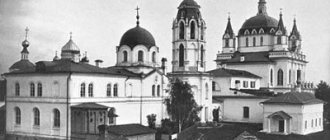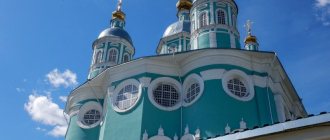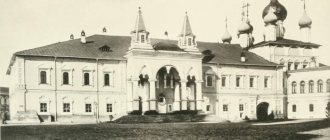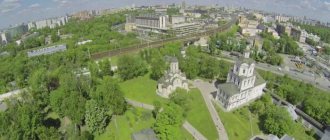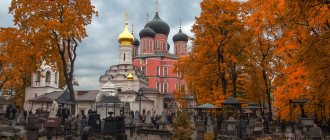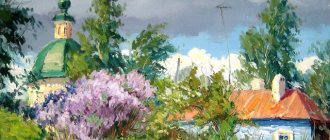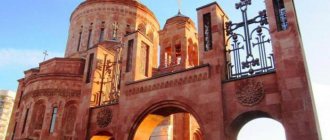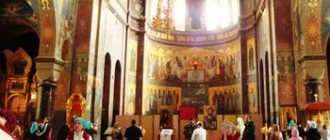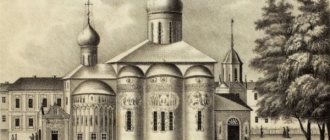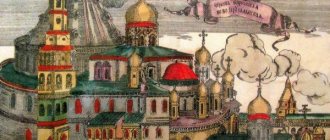"Save me, God!".
Thank you for visiting our website, before you start studying the information, please subscribe to our Orthodox community on Instagram, Lord, Save and Preserve † - https://www.instagram.com/spasi.gospodi/. The community has more than 60,000 subscribers. There are many of us like-minded people and we are growing quickly, we post prayers, sayings of saints, prayer requests, and timely post useful information about holidays and Orthodox events... Subscribe. Guardian Angel to you!
The Resurrection New Jerusalem Monastery is one of the most revered and popular communities located in the central part of the Russian state, and its distinctive feature is that the Resurrection Church located here was built in the likeness and image of the Cathedral of the Holy Sepulcher on Calvary (Jerusalem). However, in appearance, these two communities are completely different from each other. But you can find out how to get to the monastery, the schedule of services, what shrines there are and much more from this article.
What to see?
Although the city of Istra is associated with the New Jerusalem, once founded by Patriarch Nikon in exact accordance with biblical places, in addition to religious monuments, there is much more here that is no less interesting.
happy-galla.ru
It is quite possible to explore this small city in its entirety in one day, and all its attractions can be reached on foot.
Once here, you need to see:
- New Jerusalem Monastery with all its cathedrals, towers, internal churches and buildings.
- Pool of Siloam.
- Garden of Gethsemane.
- Skete of Patriarch Nikon.
- Museum of Wooden Architecture.
- Stables and cattle shed.
- Wooden sculptures from the fairy tale about the chicken Ryaba.
- Museum (exhibition hall) “New Jerusalem”.
- Pedestrian bridge with one pylon.
- Places associated with A.P. Chekhov.
- Revolution square.
- City Park.
- House of Culture and Recreation.
- Church of the Ascension.
- A square with a memorial to the fallen defenders and liberators of Istra and Nikon's cross.
- Istra Drama Theater.
- Fire building and its museum.
- Farmers' Yard Market.
- Church of the Myrrh-Bearing Women.
- Sculptures at the School of Arts.
- Friendship Square.
You need to go to the city of Istra on a fine day, with a comfortable temperature and comfortable shoes. If it rains, it’s cold, or your legs get tired, then instead of an abundance of positive and bright emotions, only bad memories will remain.
Shrines
The main cathedral of the monastery contains a fragment of the liturgical vestments of Patriarch Nikon and a model of the Jerusalem Temple, which was taken as the basis for the construction of the Cathedral of the Resurrection of the Lord.
Figure 5. Model of the Jerusalem Temple
The Resurrection New Jerusalem Monastery houses the relics of the Holy Great Martyr Tatiana. You can also pray in front of the reliquary here. Particles of the Life-giving Cross of the Lord and the holy relics of the Apostle Mark, who is the author of one of the Gospels, are sewn into it.
Resurrection Cathedral
Externally, the cathedral is interesting not only for its bizarre combination of architectural styles, which made it look like a tower from folk tales, but also for its beautiful friezes, borders and ceramic trims, on the one hand similar to Vologda lace, and on the other - very reminiscent of something Indian and Middle Eastern .
stoneblock.ru
Looking from a distance at the Resurrection Church of the New Jerusalem Monastery, it is impossible to miss not the bell tower or porch, but the large rotunda, sparkling with a heavy dome-tent with a diameter of 18 meters and three rows of dormers. Thanks to these windows, on a clear day, unique lighting is created inside, which is also an argument in favor of an excursion in good weather.
Inside the temple, in the central part of the rotunda, there is a cuvuklia, exactly imitating the original cuvuklia from the tomb in the Israeli Church of the Holy Sepulchre. Here is also the icon of the Mother of God, the famous “Three-Handed” with a human brush made of silver.
There is an interesting half-history, half-legend associated with this icon. Unfortunately, it is very difficult to look at it up close, because in front of the “Three-Handed Woman” there are always crowds of believers “to death” in dense rows, both on their knees.
Therefore, it is much easier to examine not the icon, but the Stone of Anointing and the giant golden iconostasis of 12 tiers.
mtdata.ru
The transitions in the cathedral are very interesting; against the blue background of the walls, with an abundance of stucco in the spirit of the late Baroque, you can see icon-paintings representing biblical scenes. The religious canons of painting on them are kept to a minimum, intricately intertwined with classical execution, reminiscent of the works of Renaissance masters. Very unusual and really beautiful.
New Jerusalem Temple - a living icon
The site for the construction of the monastery was chosen by the Patriarch of All Rus' Nikon, who planned to build a “copy of the Holy Land” near Moscow - an icon on the ground with a deep symbolic meaning. According to Nikon's plan, the monastery should become the center of the Orthodox world for the Slavic peoples.
About the foundation of the temple
The young Tsar Alexei Mikhailovich, the future father of Peter I, had unlimited trust in the patriarch and supported the grandiose plan. The patriarch founded his favorite creation in the Moscow region in 1656 - the residence of the Patriarchs should be located not far from the royal capital, but a little to the side. This symbolized the relationship between secular and ecclesiastical authorities.
Having never been to Jerusalem himself, Patriarch Nikon used all his strength to bring his plan to life - to create an exact likeness of the Jerusalem Church of the Resurrection of the Lord, so that the Russian people could contemplate the places of the passion and Resurrection of Christ. He cared for those who could not visit the Holy Land. A model of the Church of the Holy Sepulcher, made of ivory, was sent to Nikon as a gift by the Patriarch of Jerusalem Paisius.
Features of creating a monastery
Erecting a monastery in a bend of the Istra River on a high hill, Patriarch Nikon began to recreate a kind of temple city with an exact copy of the outskirts of Jerusalem, a semblance of the holy places of Palestine. The geographical names were changed: the hills surrounding the monastery were called Eleonsky and Tavorsky, the villages - Preobrazhenskoye, Nazareth, Capernaum.
The fast, winding Istra River was named Jordan. The stream flowing around the monastery hill is the Kidron Stream. The city of Istra was called Voskresensk until 1930. The surroundings of the future monastery were also redesigned: the forest on the banks of the Istra River was cut down to achieve similarity with the landscape in the Holy Land, the hill on which the monastery was built was strengthened and filled.
Personality of Patriarch Nikon
Using the tsar’s trust, Patriarch Nikon actually ruled the country. The energetic and powerful patriarch carried out church reforms according to the European model. Meeting the discontent of the boyars, he opposed him decisively, even harshly. Opponents of the reforms were persecuted and executed. Nikon's actions led to a terrible church schism.
In 1658, the patriarch lost the trust of the king and retired to a monastery, where he personally supervised the construction of the New Jerusalem, as he called his brainchild. The Patriarch wanted to unite people here so that they would pray together, appreciate life and each other.
In 1666, Nikon was defrocked and sent to the remote Ferapontov Monastery as a simple monk, blaming the renaming of the area in Jerusalem. The monastery under construction, whose construction was interrupted for 14 years due to Nikon’s disgrace, began to be called simply Resurrection.
underground church
The appearance of the Church of Constantine and Helena is associated with the legend of the cross on which Jesus was crucified that was found, of course, not in Istra, but in Israel. According to legend, fulfilling the orders of Emperor Constantine, the cross was discovered at a depth of 6 meters. This is exactly how deep this church is; only 33 steps lead down.
worldpics.pro
Excursions in this particular place are not particularly interesting; the guides talk a lot, but absolutely nothing. It's better to wander around inside, just reading the signs. The ditch designed to drain groundwater aside looks very interesting. It is lined with white tiles and from a distance gives the impression of a limestone vein. Many tourists throw coins at it.
Chambers and Church of the Nativity
The Church of the Nativity of Christ is not only a church building, it is a single complex that unites:
- church;
- refectory chambers with three halls;
- the abbot's chambers;
- hospital wards;
- kvass cellars;
- workshops of the chamber of maltings and blacksmiths;
- guards.
The complex is often called the chambers of Princess Tatyana Mikhailovna, this is due to the fact that all the buildings were built with her money and taking into account her wishes.
towntravel.ru
In principle, this is the only place here where the Jerusalem association is completely absent, as is the copying of biblical passages. Tours of the chambers are very interesting, especially those that tell about the structure of the kvass production and cellars, about the status division of the refectory and about the arrangement of the guardhouses.
All buildings are built strictly in the usual national version of Baroque, that is, they are similar to the buildings of the Moscow Kremlin, towers, and so on.
Defensive buildings
The New Jerusalem in Istra also has defensive buildings, the excursion program of which will allow you to escape from the abundance of information related to religious buildings.
worldpics.pro
The defense of New Jerusalem in Istra includes:
- 9 towers.
- The walls are 3-4 meters thick and 9.6 meters high.
- Loopholes in 3 rows, allowing for plantar, mounted (machiculi), and rifle combat.
- Internal parapet and “combat” passages.
This is very serious and even progressive for the military art of the 17-18 centuries and characterizes the Istra monastery complex as an almost impregnable fortress.
Each of the towers is topped with a “tent” with a light drum, and they received their names, of course, in accordance with the names of the gates of the Old City in Israel. Next to the towers there are pedestals with cannons that were in service with the monastery courtyard from the 17th to the 19th centuries.
taiellor.ru
Outside the territory, opposite the Foreign Tower, there is a source with spring and blessed water - the Pool of Siloam. Tours of the monastery lead down to it, so there is no need to go around the walls separately to see the spring.
The best way to exit the New Jerusalem complex is through the Elizabethan Gate, as it immediately opens into the Garden of Gethsemane, through which you can go to the hermitages, stand over Istra, and continue your walk outside the walls surrounding the monastery churches.
Historical reference
The museum in Istra was founded in 1922 by combining the art-historical and local history museums. The initially formed exhibition included art objects, archaeological finds and other exhibits found in estates, monasteries and temples near Moscow.
By 1940, some of the exhibits from the disbanded museum in Zvenigorod were transported to New Jerusalem. By the beginning of the Great Patriotic War, the museum already had at its disposal a huge historical and art collection.
In November 1941, the most valuable art objects were transported to Moscow, then to Alma-Ata. Part of the museum's collection was hidden in caches, but most of the exhibits remained in the galleries.
During the retreat of the German troops, the buildings of the New Jerusalem Monastery were destroyed. Work on the restoration of the museum began in the late 1940s, and only in 1959 the work on the formation of the first exhibition since the war was completed.
The Moscow Regional Museum of Local Lore, as the “New Jerusalem” was called until 1991, appeared in its current form only in 2014, after moving from the walls of the monastery to a new separate building.
© Official museum group on VK
When is the monastery open and what is the cost of visiting?
Temples and museums of the monastery complex are open for visits according to the following schedule:
- from Tuesday to Friday – from 10:00 to 18:00;
- on Saturdays – from 10:00 to 21:00;
- on Sundays – from 10:00 to 19:00.
Excursions are available in the same time mode; the guides’ working hours coincide with the opening hours of the museums and temples of the complex.
towntravel.ru
The cash desk operating hours are slightly different:
- From Tuesday to Friday, the time to purchase tickets is 10:00-17:30.
- On Saturday, the time at which you can purchase tickets is 10:00-20:30.
- Sunday – 10:00-18:30.
The time before closing, when tourists are still allowed in, is 30 minutes, but you need to understand that it’s simply not possible to explore the monastery, its museums and churches in half an hour, even superficially.
As for the pricing policy, visiting the museums, territory and churches of the monastery will cost from 255 to 455 rubles. The amount will depend on what list of objects will be selected and whether the services of guides will be required.
You can quite save on paying for excursions; at the entrance to the complex and above its ticket office there is a detailed diagram of the entire monastery courtyard, and if you wish, you can listen to the guides while standing near the tourist groups, as they talk quite loudly.
Video: New Jerusalem Monastery.
